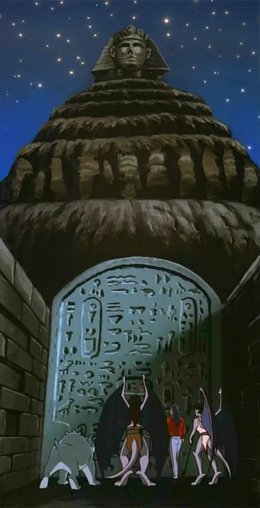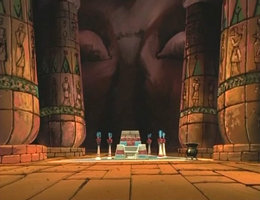Difference between revisions of "Sphinx"
Supermorff (talk | contribs) (rm cat. +dab) |
Phoenician (talk | contribs) (I wanted to add a bit more of what can be found on the main Wikipedia page, but with some episode context too.) |
||
| (10 intermediate revisions by 7 users not shown) | |||
| Line 1: | Line 1: | ||
[[Image:Sphinx.JPG|thumb|260px|The Sphinx]] | [[Image:Sphinx.JPG|thumb|260px|The Sphinx]] | ||
| + | |||
:''For the character of the same name, see [[Sphinx (New Olympian)]] | :''For the character of the same name, see [[Sphinx (New Olympian)]] | ||
'''The Sphinx''' is a famous monument in Giza, [[Egypt]]. | '''The Sphinx''' is a famous monument in Giza, [[Egypt]]. | ||
==History== | ==History== | ||
| − | The Sphinx was | + | The Sphinx is of ancient origin. [[Goliath]] remarked that it was already ancient long [[Timeline#Before 994|before]] he hatched. |
| + | |||
| + | Between the Sphinx's front paws lies a secret doorway. Beyond this door lies a staircase leading up inside the monument into several chambers, including at least one burial chamber. Inside the Sphinx's head is a large temple. This is where the [[Emir]] and the [[Pack]] summoned [[Anubis]] using the [[Scroll of Thoth|Scroll]] of [[Thoth]] and the sacred [[Tanna Leaves]]. Goliath and his companions encountered Anubis, the Emir, and the Pack in this temple when they came to Egypt on the [[Avalon World Tour]]. Afterwards, the Emir sealed off the complex so that nobody could ever enter it again. ''([[Grief|"Grief"]])'' | ||
| + | [[Image:Sphinx2.JPG|thumb|left|260px|The Temple]] | ||
| + | |||
| + | ==Real World Background== | ||
| + | Made of limestone, the Sphinx was sculpted in the middle of the 3rd millennium B.C. by the Pharaoh Khafre, the builder of the Second Pyramid in Giza. The monument depicts Khafre in the form of a sphinx, a lion with a [[human]] head. It is believed to have been sculpted from the bedrock that also served as a quarry for the ancient necropolis. Unlike what was depicted in the [[Gargoyles (TV series)|series]], evidence of a temple space in front of the monument (let alone inside it) was never completed. | ||
| + | |||
| + | About four hundred years later, the site was largely abandoned and the Sphinx was eventually buried in sand up to its shoulders. While its burial naturally protected the monument from erosion for much of existence, ancient excavations are believed to have been undertaken – first under the direction of Pharaohs Thutmose IV and Rameses II in the 2nd millennium B.C., and later in the 1st Century A.D. in honor of the [[Rome|Roman]] Emperor Nero. Modern excavations began in the 19th Century, and it has largely been exposed to the present day. | ||
| + | |||
| + | While the original name of the Sphinx is unknown, Thutmose IV associated the sculpture with the Sun diety, ''Hor-em-akhet'' ("Horus of the Horizon") on the stele he erected between the Sphinx's paws during his reign (this stele is located much where the secret door into the Sphinx was located in the episode "Grief"). The modern Egyptian Arabic name is أبو الهول (''ʼabu alhōl / ʼabu alhawl''), literally "Father of Dread". The English word ''sphinx'' comes from the Greek Σφίγξ, which is related to the Greek verb σφίγγω meaning "to tighten"; it is likely an association to how lions kill their prey through strangulation (i.e. asphyxiation), which was the manner the mythical Theban sphinx attacked its victims until she was defeated by Oedipus. | ||
| − | + | Today it ranks alongside the Pyramids as the best-known symbol of ancient Egypt. | |
| − | ==See | + | <br style="clear:left;"/> |
| + | ==See Also== | ||
*{{wikipedia|Great_Sphinx_of_Giza}} | *{{wikipedia|Great_Sphinx_of_Giza}} | ||
[[Category:Canon places]] | [[Category:Canon places]] | ||
[[Category:Real world places]] | [[Category:Real world places]] | ||
Latest revision as of 00:38, 6 May 2024
- For the character of the same name, see Sphinx (New Olympian)
The Sphinx is a famous monument in Giza, Egypt.
History
The Sphinx is of ancient origin. Goliath remarked that it was already ancient long before he hatched.
Between the Sphinx's front paws lies a secret doorway. Beyond this door lies a staircase leading up inside the monument into several chambers, including at least one burial chamber. Inside the Sphinx's head is a large temple. This is where the Emir and the Pack summoned Anubis using the Scroll of Thoth and the sacred Tanna Leaves. Goliath and his companions encountered Anubis, the Emir, and the Pack in this temple when they came to Egypt on the Avalon World Tour. Afterwards, the Emir sealed off the complex so that nobody could ever enter it again. ("Grief")
Real World Background
Made of limestone, the Sphinx was sculpted in the middle of the 3rd millennium B.C. by the Pharaoh Khafre, the builder of the Second Pyramid in Giza. The monument depicts Khafre in the form of a sphinx, a lion with a human head. It is believed to have been sculpted from the bedrock that also served as a quarry for the ancient necropolis. Unlike what was depicted in the series, evidence of a temple space in front of the monument (let alone inside it) was never completed.
About four hundred years later, the site was largely abandoned and the Sphinx was eventually buried in sand up to its shoulders. While its burial naturally protected the monument from erosion for much of existence, ancient excavations are believed to have been undertaken – first under the direction of Pharaohs Thutmose IV and Rameses II in the 2nd millennium B.C., and later in the 1st Century A.D. in honor of the Roman Emperor Nero. Modern excavations began in the 19th Century, and it has largely been exposed to the present day.
While the original name of the Sphinx is unknown, Thutmose IV associated the sculpture with the Sun diety, Hor-em-akhet ("Horus of the Horizon") on the stele he erected between the Sphinx's paws during his reign (this stele is located much where the secret door into the Sphinx was located in the episode "Grief"). The modern Egyptian Arabic name is أبو الهول (ʼabu alhōl / ʼabu alhawl), literally "Father of Dread". The English word sphinx comes from the Greek Σφίγξ, which is related to the Greek verb σφίγγω meaning "to tighten"; it is likely an association to how lions kill their prey through strangulation (i.e. asphyxiation), which was the manner the mythical Theban sphinx attacked its victims until she was defeated by Oedipus.
Today it ranks alongside the Pyramids as the best-known symbol of ancient Egypt.
See Also
- Sphinx at Wikipedia, the Free Encyclopedia

